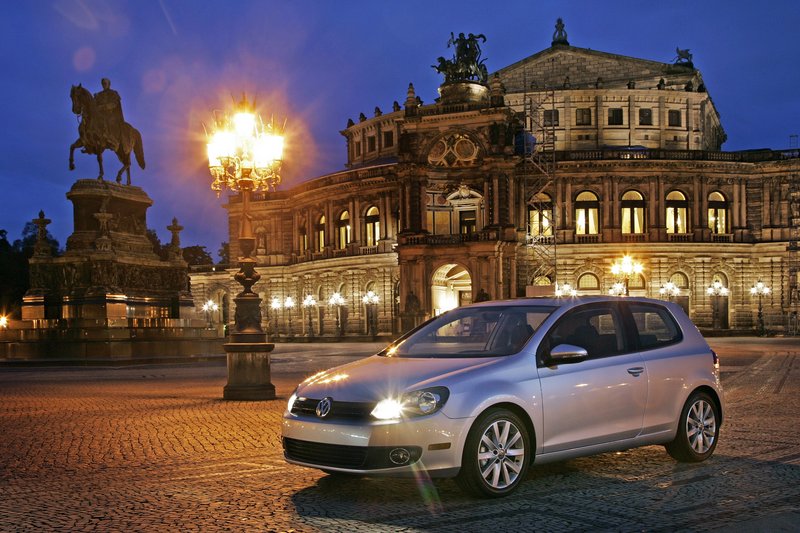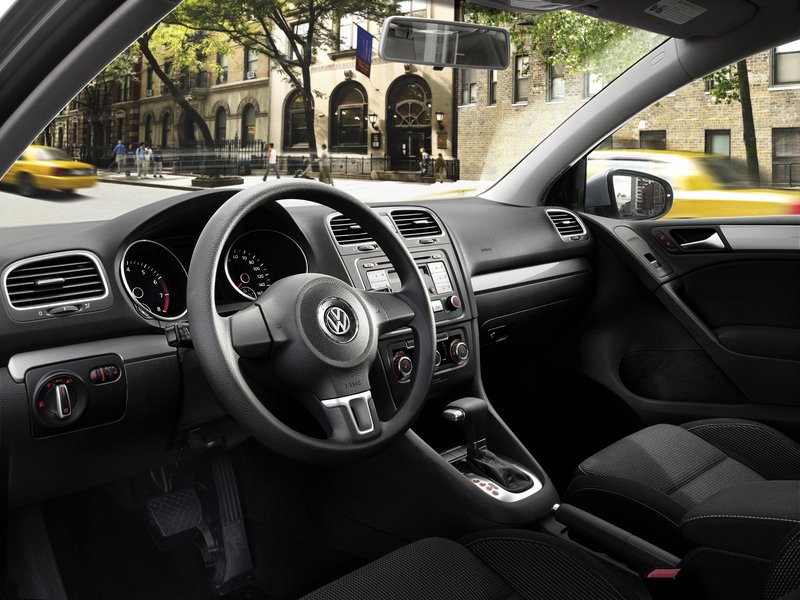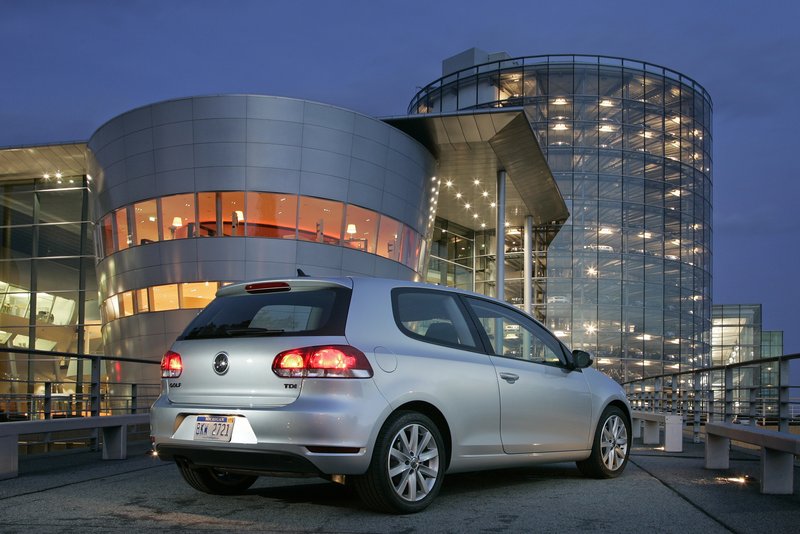– The woman must have been daft, I thought, as I started up the 2010 Golf and began driving.
She had told me the only thing she didn’t like about the car was having to find a station that sold diesel when stopping for fuel. I wondered how long it would take before the engine started coughing and died an inglorious death, because this obviously wasn’t a diesel engine.
It was too quiet; too smooth. There were no smelly exhaust fumes.
It moved out effortlessly and shot forward when I mashed the throttle.
Those are not characteristics of the diesel engines most Americans have come to know and dislike.
Picture a diesel-powered vehicle and most of us think of noise, sluggishness and stink. Diesel engines sound like a disgruntled autoworker threw a handful of marbles into the cylinder block during assembly. They smell like an NHL locker room after a six-period, sudden-death overtime playoff game.
But those qualities seemed like attributes compared to diesel engine acceleration. The first Volkswagen diesel I drove — probably a couple of decades ago — felt as if it was powered by a hamster wheel and two of the three hamsters had died.
The 2010 Golf exhibited none of those attributes. I’d driven new diesel models from Audi and Mercedes-Benz that eliminated the typical diesel bugaboos, but those were luxury vehicles. I didn’t think an affordable compact such as the Golf would have such a sophisticated engine.
So I floored the Golf the first chance I got. The car responded like my cat, Rocky, when a dish falls and breaks. It took off instantly, pushing me back in its seat.
That pretty much confirmed my suspicions that this Golf wasn’t a diesel. So did my stopwatch, which recorded a zero-to-60 launch of 8.4 seconds.
I was impressed with the 2010 Golf, which represents the first edition of this venerable compact car’s sixth generation. It looks a lot like its predecessor, only sleeker, wider and with a more machismo posture.
The body-color front bumper bisects a wider, two-horizontal bar grille and deeper, broader blacked-out air intake. At the front corners, angled headlight bezels with crystalline fog lights sweep into the front quarter-panels. The taillights also are wider and sweep into the rear quarter panels.
I’m impressed with the new Golf’s styling — particularly the two-door version I was testing — because it looks more like a sporty coupe than an affordable compact. But one thing I immediately noticed on my first walk-around disturbed me: The three letters just below the right taillight that read T-D-I.
Those letters signified that my test car was, indeed, powered by a diesel engine. It made me question how much I really know about automobiles.
One thing I now know about the Golf TDI is that it’s a terrific alternative for those seeking high-mileage transportation and thinking they might need either a conventional vehicle with a puny power plant or a hybrid. Granted, eight-plus seconds to get from zero to 60 isn’t Lamborghini-like, but it’s quicker than most cars this roomy that are capable of squeezing 42 miles from a single gallon of gas.
That is the EPA highway mileage rating for my Golf TDI test vehicle, which also earned a 30-mpg city rating. According to the Golf’s onboard trip computer, I averaged around 45 mpg on a 90-mile highway trip and around 40 mpg for my weeklong evaluation.
Those are impressive numbers, even when taking into account that I paid 23 cents a gallon more for diesel fuel than I would have paid for regular unleaded. Making the mileage even more impressive is that the Golf TDI doesn’t feel or behave like an economy car.
That’s because its 2.0-liter, turbocharged four-cylinder produces a very “un-economy-car-like” 236 pounds-feet of torque. And the engine delivers that power at as little as 1,750 rpm.
Compare that to the non-diesel Golf, which with its relatively large, 2.5-liter, five-cylinder engine is pretty potent compared to most compacts. Yet its torque tops out at 177 pounds-feet, and the engine must be spinning at 4,250 rpm to produce it.
The Golf TDI not only has much more thrust than most high-mileage vehicles, but also delivers it almost as soon as it starts rolling. And its turbocharger helps produces extra punch when the gas pedal is prodded.
Most of the time, anyway. Once or twice during the week, mashing the pedal momentarily produced no response. I’m not sure if it was “turbo-lag” or some other hiccup.
Otherwise, the power train was a constant pleasure. The Golf TDI is available with either a conventional six-speed manual transmission or a six-speed “DSG” (Direct Shift Gearbox) automatic. My car was equipped with the latter, a $1,100 option. Think of it as a manual that shifts itself. Dual clutches make the shifts fluid and quick while providing greater operating efficiencies than a conventional automatic.
The sporty transmission, with VW’s vaunted “Tiptronic” feature that puts a manual shifting override at the driver’s fingertips, seems a perfect fit in Golf TDI. That’s because the TDI is equipped with the same tire/wheel combination as its high-performance GTI stable mate, and a similar sport-tuned suspension.
The high-performance tires and sport suspension deliver a firm but comfortable ride. The TDI’s suspension, meanwhile, keeps it firmly grounded regardless of road conditions or the driver’s adrenalin level. The quick and nimble TDI is a fun car to drive whose pleasure increases along with the number of curves in a road.
My fondness for Volkswagen’s new Golf TDI seemed to increase, in fact, the longer I had it and the more miles I covered in it. And as those miles accumulated, my appreciation for its miserly fuel consumption grew.
Who knew a diesel-powered vehicle could be as much fun, as refined and as affordable as the Golf TDI?
Scott Wasser is executive editor of MaineToday Media. He writes a weekly auto column for the Sunday Telegram and other newspapers. He can be reached at
swasser@pressherald.com
Send questions/comments to the editors.





Success. Please wait for the page to reload. If the page does not reload within 5 seconds, please refresh the page.
Enter your email and password to access comments.
Hi, to comment on stories you must . This profile is in addition to your subscription and website login.
Already have a commenting profile? .
Invalid username/password.
Please check your email to confirm and complete your registration.
Only subscribers are eligible to post comments. Please subscribe or login first for digital access. Here’s why.
Use the form below to reset your password. When you've submitted your account email, we will send an email with a reset code.